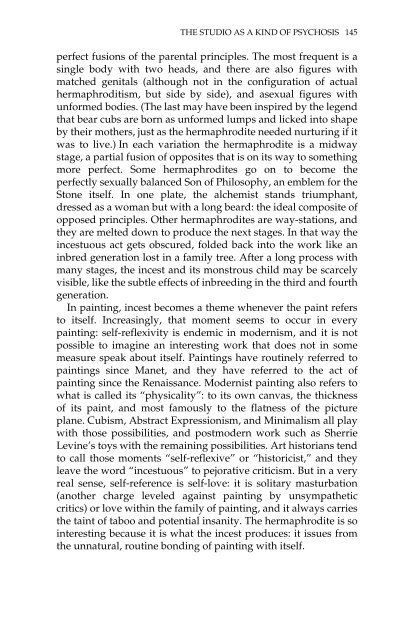What Painting Is: How to Think about Oil Painting ... - Victoria Vesna
What Painting Is: How to Think about Oil Painting ... - Victoria Vesna
What Painting Is: How to Think about Oil Painting ... - Victoria Vesna
Create successful ePaper yourself
Turn your PDF publications into a flip-book with our unique Google optimized e-Paper software.
THE STUDIO AS A KIND OF PSYCHOSIS 145<br />
perfect fusions of the parental principles. The most frequent is a<br />
single body with two heads, and there are also figures with<br />
matched genitals (although not in the configuration of actual<br />
hermaphroditism, but side by side), and asexual figures with<br />
unformed bodies. (The last may have been inspired by the legend<br />
that bear cubs are born as unformed lumps and licked in<strong>to</strong> shape<br />
by their mothers, just as the hermaphrodite needed nurturing if it<br />
was <strong>to</strong> live.) In each variation the hermaphrodite is a midway<br />
stage, a partial fusion of opposites that is on its way <strong>to</strong> something<br />
more perfect. Some hermaphrodites go on <strong>to</strong> become the<br />
perfectly sexually balanced Son of Philosophy, an emblem for the<br />
S<strong>to</strong>ne itself. In one plate, the alchemist stands triumphant,<br />
dressed as a woman but with a long beard: the ideal composite of<br />
opposed principles. Other hermaphrodites are way-stations, and<br />
they are melted down <strong>to</strong> produce the next stages. In that way the<br />
incestuous act gets obscured, folded back in<strong>to</strong> the work like an<br />
inbred generation lost in a family tree. After a long process with<br />
many stages, the incest and its monstrous child may be scarcely<br />
visible, like the subtle effects of inbreeding in the third and fourth<br />
generation.<br />
In painting, incest becomes a theme whenever the paint refers<br />
<strong>to</strong> itself. Increasingly, that moment seems <strong>to</strong> occur in every<br />
painting: self-reflexivity is endemic in modernism, and it is not<br />
possible <strong>to</strong> imagine an interesting work that does not in some<br />
measure speak <strong>about</strong> itself. <strong>Painting</strong>s have routinely referred <strong>to</strong><br />
paintings since Manet, and they have referred <strong>to</strong> the act of<br />
painting since the Renaissance. Modernist painting also refers <strong>to</strong><br />
what is called its “physicality”: <strong>to</strong> its own canvas, the thickness<br />
of its paint, and most famously <strong>to</strong> the flatness of the picture<br />
plane. Cubism, Abstract Expressionism, and Minimalism all play<br />
with those possibilities, and postmodern work such as Sherrie<br />
Levine’s <strong>to</strong>ys with the remaining possibilities. Art his<strong>to</strong>rians tend<br />
<strong>to</strong> call those moments “self-reflexive” or “his<strong>to</strong>ricist,” and they<br />
leave the word “incestuous” <strong>to</strong> pejorative criticism. But in a very<br />
real sense, self-reference is self-love: it is solitary masturbation<br />
(another charge leveled against painting by unsympathetic<br />
critics) or love within the family of painting, and it always carries<br />
the taint of taboo and potential insanity. The hermaphrodite is so<br />
interesting because it is what the incest produces: it issues from<br />
the unnatural, routine bonding of painting with itself.


